Weekly round-up: 09 - 15 Apr 2014
April delivered some lovely weather this week (and some less-lovely weather too it has to be said) but there was little doubting just how lovely some of the birds were this week.
Most areas got sunshine, the south seeing temperatures climb to the edge of the high teens though weak weather fronts (mainly on the western side of Britain) did deposit some weekend showers.
The end of the week saw high pressure kicking in and those beset by a cool northerly airflow look set to see a more migrant friendly east or southeast breeze set in, to go with the sunshine and blue skies.
..and to give the bird news an all together sunnier demeanour still, a lot of people managed to unblock a rather dinky mega too.
There we go ~ that’s definitely more like it…
With the newly arrived early spring vibes already on the tidy side of none-too-shabby, it was always going to be interesting to try and assimilate just what could be the first bird to truly get the heart racing as March cast aside her weary woes and April had seen the clocks pass us across in to the warming hands of summer time. Fresh blood was starting to arrive from distant shores ~ it was starting to get tasty…
…that’s not to say that the early sparkle and glamour of a (decent each-way bet) couple of eternally snazzy Great Spotted Cuckoos was anything to be baulked at ~ far from it ~ but we’ve been teetering on the brink of something to satisfy the expectant masses and on 11th came a suitably impressive offering from the birding gods.
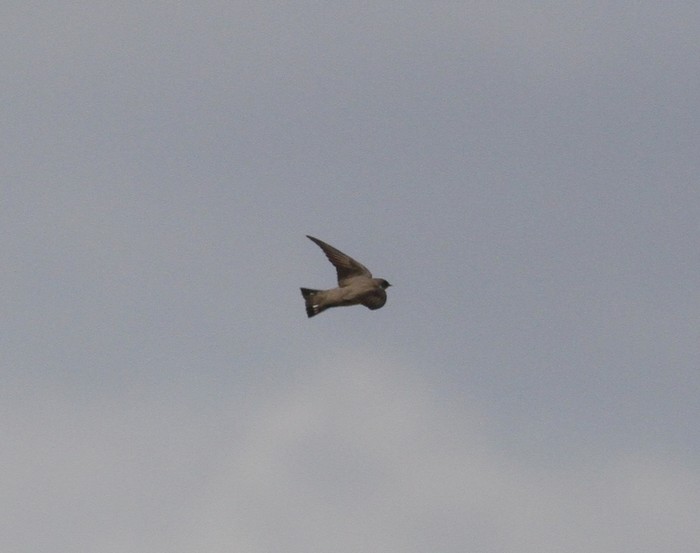
Having already clocked up the first of 2014’s ever-delightful Red-rumped Swallows, birders at East Yorkshire’s outstanding migrant location Flamborough Head were already in the zone where mobile high flyers were concerned. They duly went and upped the stakes, considerably so too, just as the mug of coffee was being placed on the table and the last blob of Marmite was eased off a toasty slab on a pleasing Friday morning across the country as Andrew Allport discovered Britain’s 10th-ever Crag Martin just to the south of the headland’s foghorn, around an area known as High Stacks.
A massive national bird which, despite now hitting double figures is (as is often the way with birds-on-the-wing) has been notoriously tricky to connect with ~ our only twitchable bird to date was the individual seen at Swithland Reservoir in Leicestershire on the super Saturday of April 17th 1999, a bird that (incredibly) was relocated the following day off to the north, at Pugney’s and Angler’s Country Parks in West Yorkshire.
A fortnight or so later, another (?) Crag Martin was seen on Orkney on May 3rd and just two more have followed, both of them in autumn, both of them “down south” (in Surrey and Sussex) and both them not really playing the game so required by the chasing pack.
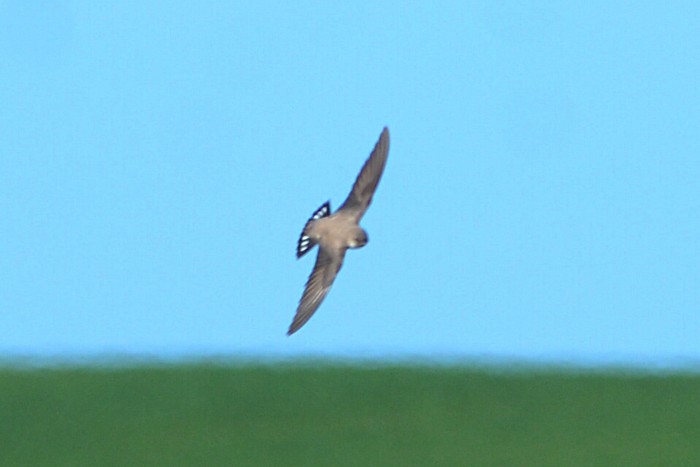
This week’s Crag Martin did give folk a chance ~ mainly thanks to such fabulously prompt dissemination of news. Anyone within three and a half hours of Flamborough who had the opportunity to drop everything ~ there and then ~ and have a go at it was in with a fighting chance ~ on show (off and on) until it seems around 1235, when it was last seen drifting towards Bridlington from the South Landing area of the headland…
..but, of course, that wasn’t the end of the story.
Despite the information being written large that it drifted off towards the North Landing and Thornwick Bay area, it seems as though few of the dippers on Friday took up the challenge to cast their eyes that way, opting for the South Landing return option instead. On the afternoon of 12th, some bright spark did decide to venture to the area where it had been seen heading away towards the previous day ~ BINGO! ~ thar’ she blows!
The Crag Martin performed off and on in the same general area from around lunchtime to the other side of 7pm before, presumably heading off to roost ~ opening up an longer window of opportunity than Day 1 in the process ~ and showing well in to the bargain. On 13th the early risers managed to connect but by 8am the bird had headed from north of the lighthouse and back towards the fog station…and that seemed to be it…becoming a salutary lesson learned for any post 8am dippers.
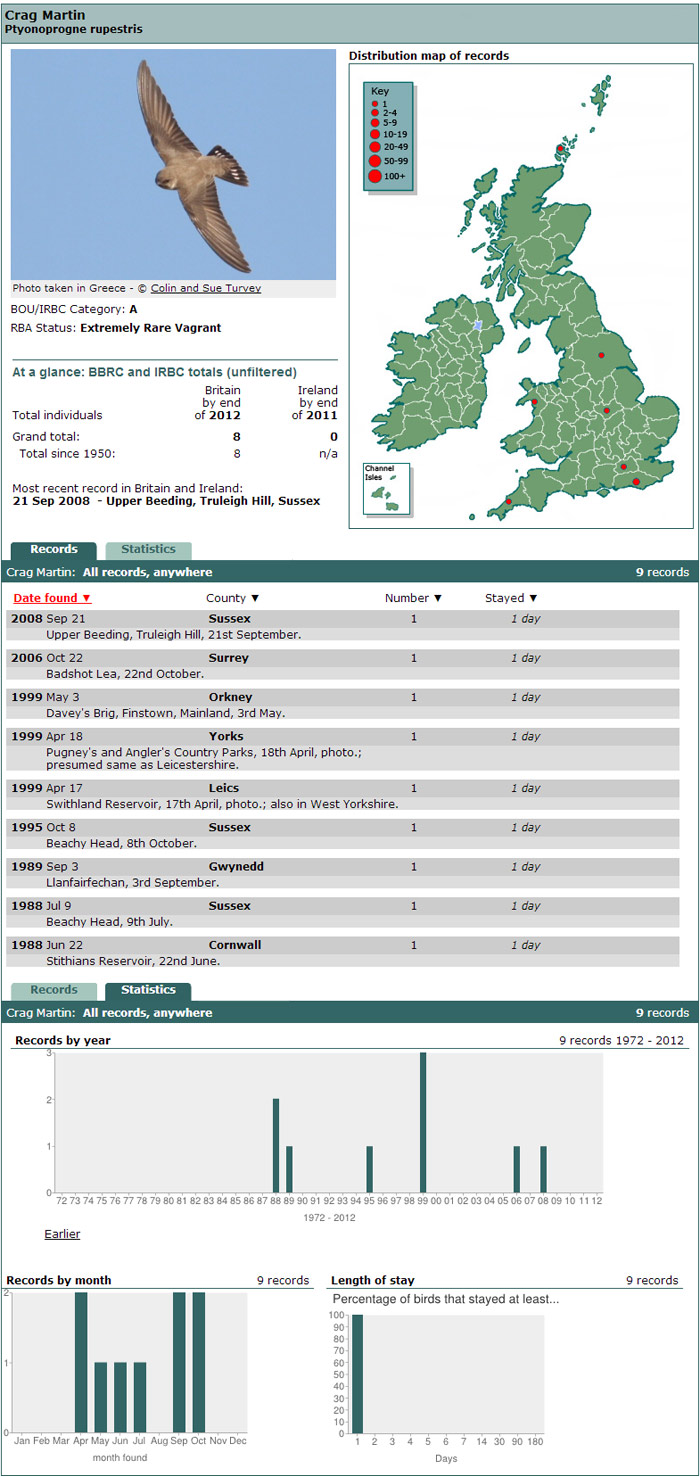
The spread of records for the species here to date is wide and broad. As well as the two records within Yorkshire as a whole (one each now for the West and the East) and three for Sussex (two for the East ~ both at Beachy Head ~ and for one the West), we also have the aforementioned records from Leicestershire, Orkney and Surrey. Add in one from north Wales (at Llanfairfechan in September 1989) and Britain’s first, the brief visitor over the causeway at Cornwall’s Stithians Reservoir on June 22nd 1988 and it is, pretty much impossible to predict where and when they’ll ever appear.
That said, early spring at Flamborough would have been in the box marked “good guess” for me…
Last seen on April 5th, it seemed as though the handsome drake Baikal Teal had “done the right thing” and departed Cambridgeshire at a suitably impressive time and there’d be no questions asked about provenance.
While the murmurings will be held at bay for a while longer (early to mid-May is the cut off) it was a surprise when the bird reappeared further along the Ouse Washes this week, seen near Pymoor on 14th-15th ~ though the heat haze, shimmer and extreme distance on the second of these two dates meant it was nothing more than a custard-faced quacky-splodge for most of the day. Which it wasn’t of course, but it was distant.
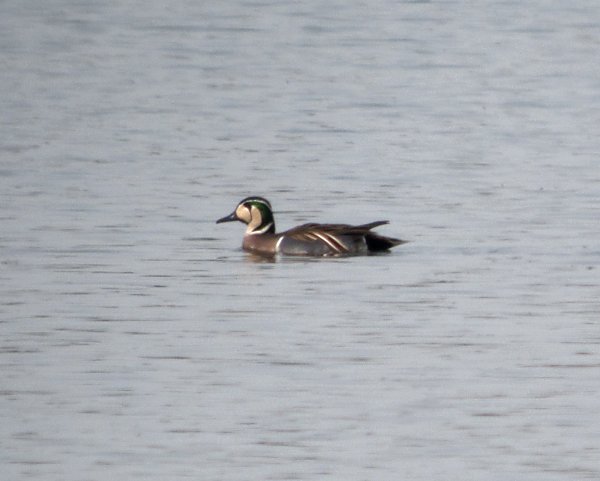
Given the size of the area in question, it could lurk in the area for several more days to come but it is also just a (wire-)hop, skip and a jump away from the Norfolk border…tantalisingly close in fact ~ with some county listers on Red Alert for the next gentle move north.
Assuming this Baikal Teal doesn’t do anything daft and stay through the summer, it will be a shoe-in for acceptance. Sadly the same can’t be said for the cracking drake Falcated Teal (as they used to be known…) that was located at the extremely close-by Welney in December 1986, returning the following autumn with the first Wigeon before exiting via Cley in both May 1988 and May 1989. Still languishing in Category D, and likely to stay there for the foreseeable future, it seems that like other obvious wildfowl vagrants such as Wood Duck and White-headed Duck, Falcated Duck somehow doesn’t past muster in the way some accepted Hooded Mergansers and Buffleheads have. And that is just plain daft.
Prior to the all the Martin malarkey, the first bit of innarestin’ news (worthy of an exciting, though ultimately slightly deflating Mega Alert) was the appearance in (funnily enough) Leicestershire of the county’s first-ever Pied-billed Grebe which was discovered at Rutland Water on 9th, at the start of the new review week.
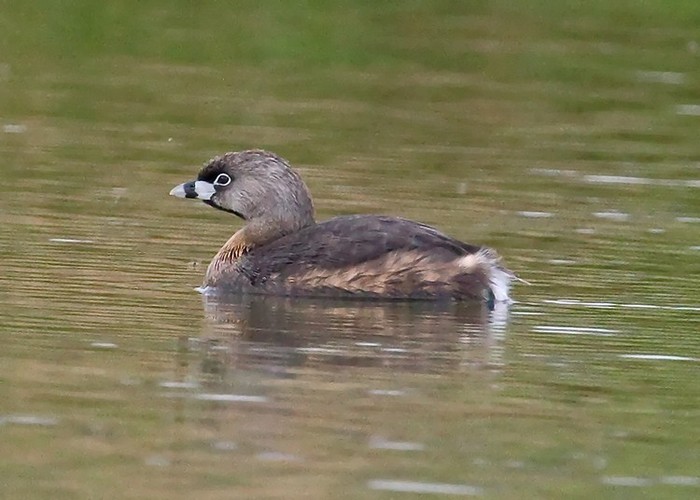
A super inland find, the bird performed admirably on site for a couple of days before taking its leave sometime overnight on 10th into 11th. Despite plenty of nice red dots across many English counties (Leicestershire becomes the 15th to register the species) there’s been a four year gap since the last one away from Celtic nations ~ the popular bird at Hollingworth Lake in Greater Manchester for a fortnight in November 2010 being then most recent English record.
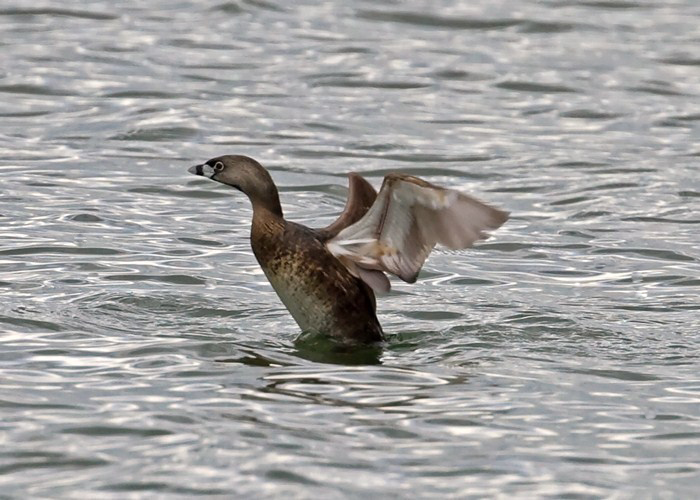
Spring Pied-billed Grebes remain relatively rare ~ this week’s bird makes it 10 in all for April (spread from Cornwall to Highland) and it isn’t that often that we can report two of these perky Podilymbus’ but we can this week due to the continuing presence of the wintering bird on North Uist, still around the Balranald RSPB reserve up until the end of the review period.
On the Isles of Scilly, birders on St. Mary’s continued to enjoy the suitably secretive Sora around the Lower Moors area until at least 10th. Furtive to the last, this super crake is looking really rather snappy now and it seems a shame that more birders aren’t enjoying it (though it has now been usurped by a Spotted Crake in the same spot ~ perhaps both individuals overwintered on Scilly?)
…meanwhile, some 800 miles or so to the north, Loch Flemington’s (currently) faithful old American Coot was still doing the biz for any passers-by, present there to 14th (99 days and counting now…exciting isn’t it…!). It seems to be in little hurry to head off and with a suitable companion to hand, maybe it’ll be there for some while to come ~ and let’s hope someone has checked the Common Moorhen it is purported to be hooked up with currently isn’t actually a Common Gallinule.
…I’ll leave that one with you…
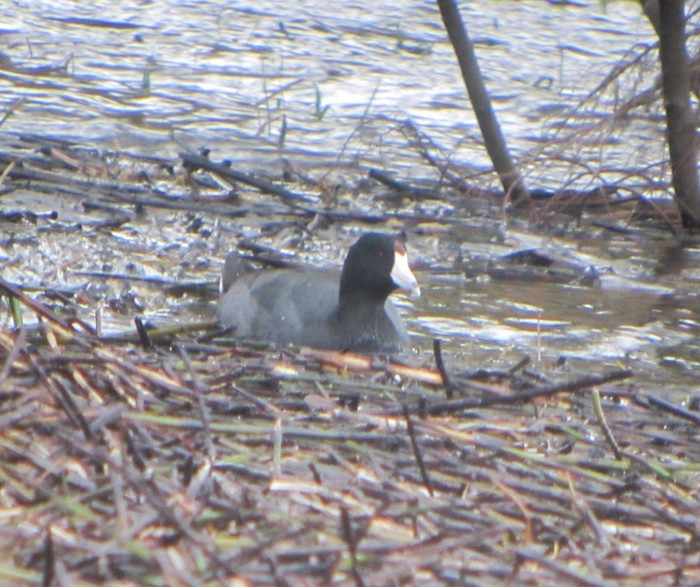
Black-winged Stilt is a species that is highly unlikely to feature in the headline news unless it was down to something extraordinary like a successful breeding attempt or bonkersly-big flock of them springing a surprise somewhere.
This week we can report on the latter as the option that scorches these shocking-pink, long-legged wonder-of-a-wader into one of the top spots of the week ~ a record-equalling flock of 10 found on the Brading Marsh RSPB Reserve (Isle of Wight) on the evening of 12th.
Twos, threes and even fours are not unheard of, indeed pairs appearing together is almost the norm. But numbers above four are scarce indeed ~ a Saturday jaunt through the files revealed six accepted records for groups of five (in Suffolk in April 1949, Devon in September 1967, Essex in September 1968, Cork in April 1990, Norfolk in June 2010 and Devon in April 2012).
County Cork popped in a six in March 1990 (at Ballycotton, several days before five were at Rostellan, mentioned above) while by default, the famous Nottinghamshire breeding pairs in the summer of 1945 eventually totalled seven birds when three of the young fledged. But our only 10 to date came at Bovisand in Devon, also in 1945, appearing there in the spring of that year.
Before heading off to Seabird City, mention should be made of other Black-winged Stilts this week ~ two birds appeared at Bowers Marsh RSPB (Essex) on 11th and what may have been the same two (no shots to compare yet) relocated to Bestwell RSPB, near Wareham (Dorset) on 12th, where they remained to 13th at least. Then, to confuse matters (well, me at any rate) a pair were seen again in Essex on 14th-15th, this time at Old Hall Marshes RSPB where the appeared to be getting down to some bubble-gum-legged jiggy-jiggy.
After all the exciting scenes of the flotilla of buttery-tip ivory-billed beauties off the coast of Aberdeenshire in the last couple of week, numbers of White-billed Divers receded quicker than a footballer’s hairline this week with just two singles recorded for most of the week ~one a piece for Herston, South Ronaldsay (Orkney) on 10th and St Abb’s (Borders) on 12th. Then on 15th, three birds were seen again on the sea off Portsoy.
A handful of early spring Pomarine Skuas included two threes in Dumfries & Galloway on 12th (at Newbie and Luce Bay) with four noted off Balranald RSPB on North Uist the same day.
…and that appeared to be that out to sea this week…
As winter slips away, so do our numbers of wintering herons etc., and with another week closer to the middle of April numbers of Glossy Ibis made it double figures once again, with 16 birds recorded from Britain and Ireland this week. The Midlands and Ireland fared best ~ four birds in both including two at Belvide Reservoir (Staffordshire) on 10th, one of which lingered to 13th, with singles at Ladywalk NR (Warwickshire) on 9th and another loitering at Lowdham (Nottinghamshire) to 13th while Irish birds included two at Oxford Island NNR (Co. Armagh) and singles in Derry (at Lough Beg) and Antrim (at Larne Lough).
Next with two each were the southeast with singles in East Sussex and Kent (at Lewes Brooks and Grove Ferry NNR) and the southwest (one still at Cornwall’s Gillan Creek and another at Weston sewage works in Somerset on 12th) across the weekend. Elsewhere, a Glossy Ibis was noted over Horwich (Greater Manchester) on 11th and the previous day saw one logged at Southwold (Suffolk). The week ended with two in the same field of view as the Baikal Teal at Pymoor, with a lovely looking herony right behind them. Ooo-eeeer.
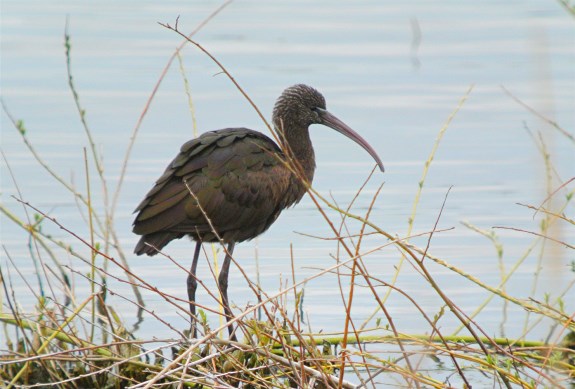
Derbyshire scored a Cattle Egret on 9th, present at Carsington Water at dusk, and Devon picked one up too ~ seen at Colyford Common LNR on 10th. Cambridgeshire has been a particularly busy county of late and local birders would have been chuffed by the appearance of a Cattle Egret on the Nene Washes on 12th, a bird which relocated to Eldernell later in the day where it stayed to 13th, with a Great White Egret also on site there for good measure.
The latter species dropped in number as well this week ~ 13 recorded countrtywide including a further two in Cambridgeshire, on the Ouse Washes on 12th, two again in Northamptonshire (at Stanwick on 10th) and a couple of singles (at least) in Somerset. The south coast saw lone birds noted on the Isle of Wight on 12th and in West Sussex on 13th and east coast Great White Egrets were in Suffolk (heading south over Landguard on 13th), Lincolnshire (at Frampton Marsh to 12th), Cleveland (at Dorman’s Pool on 10th) and in Northumberland (at Arcot Hall on 9th).
Aside from a couple of lone coastal singles in East Anglia, and a wintering youngster in County Down, all of the remaining 19 Spoonbills were seen in southern England, with 12 at Arne RSPB (Dorset) on 14th the largest gathering. The others were all single birds and were seen from Dorset through every coastal county east to Kent with one in Gloucestershire too.
South Wales hosted the largest gathering of Grus this week when six birds were seen over at. Athan (Glamorgan) on 10th with five Cranes the following day in Cardiff and a single in neighbouring Gwent, at the Newport Wetlands. A flock of three birds reported heading over Colyford Common in Devon on 10th where then seen on 11th at Stoborough (Dorset) while two birds that headed over Blacktoft Sands RSPB (East Yorkshire) on the morning of 12th where then seen at Alkborough Flats (Lincolnshire) the same afternoon. Six Common Cranes were recorded in Norfolk (two twos in the east, one on the north coast and one in the far west), with one for Kent, at Swale NNR on 9th.
Aside from the remarkable swapsies on Scilly, the only other Spotted Crake reported this week was from the Cambridgeshire Washes where one was singing after dark at Wicken Fen NT on the evenings of 9th-10th and 10th-11th.
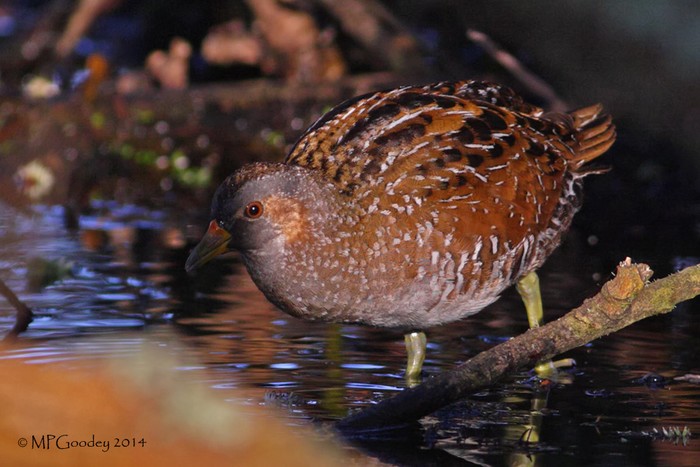
Four is the magic number this week for Snow Geese with two Scottish mainland pairs the only representatives of the species on offer ~ the pair of an intermediate and white bird were still at Tayinloan (Argyll) to 10th while the blue birds lingered at Braehead (Clyde) to 12th. The only other goose of note was a Black Brant that was at Loompit Lake (Suffolk) on 9th.
An elusive drake Lesser Scaup was at Siblyback Reservoir (Cornwall) on 12th while in Cambridgeshire there were two Ring-necked Ducks up for grabs this week ~ the female was still on the Ouse Washes RSPB to 13th at least while a drake was found at March Farmers on 11th where it stayed to 14th. Around the rest of the country, the 9th saw the female noted as still present on North Uist (Outer Hebrides), the male was still on Shetland’s Loch of Asta with the same date seeing a drake appear at Lough Skean (Co. Sligo). New too was the drake Ring-necked Duck on Abberton Reservoir (Essex) from 12th. Northumberland’s drake Ferruginous Duck was last seen on Gosforth Park Lake on 9th.
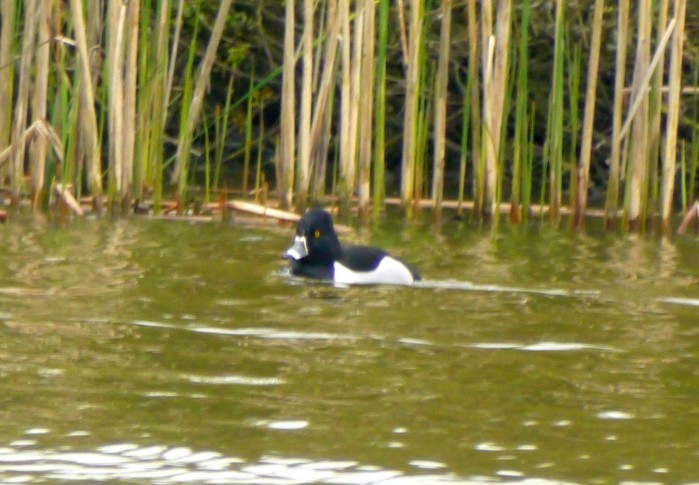

On the Orkney mainland, a drake Blue-winged Teal was found on The Shunan on 13th, the third record for the islands within the last 12 months.
Also on Orkney was one of the 10 Green-winged Teals logged this week, seen again on North Ronaldsay on 11th. Numbers are holding steady at 10 again, with singles still at Blashford Lakes (Hampshire) and Morton Bagot (Warwickshire) as the week began and then the newbies began to be found. Almost inevitably, one was found on the Ouse Washes in Cambridgeshire, seen at Pymoor from 10th, while four of the half dozen noted on 12th were new ~ at East Stobswood Pool (Northumberland), Blacktoft Sands RSPB (East Yorkshire), Quoile Pondage (Co. Down) and Maer Lake CBWPS (Cornwall). Lingering singles on the same day were at East Tilbury (Essex) and Loch Gruinart RSPB, Islay (Argyll).
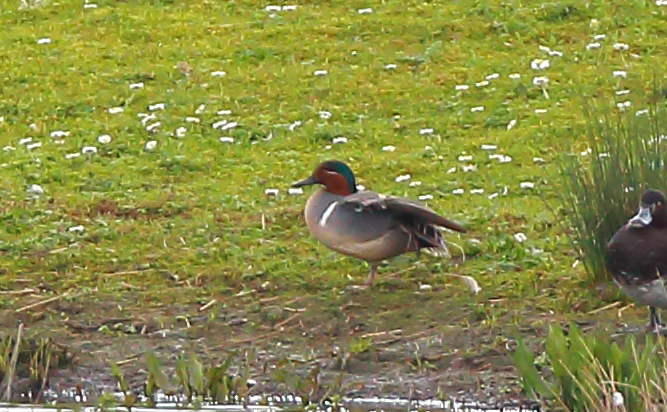
A trio of queen King Eiders were on offer across the past few days ~ still off Portnoo (Co. Donegal), Fidra (Lothian) and Ruddon’s Point (Fife), all to 12th.
Surf Scoters were similarly thin on the ground too ~ the young drakes hanging around Mount’s Bay (Cornwall) and Dawlish Warren (Devon) both to 14th at least while an adult drake was again in the mouth of the River Esk at Musselburgh (Lothian) to 15th.
Spring Dotterels are an annual early spring treat and the traditional stopping-off trip-hop spot of Pendle Hill in Lancashire gathered the first of the year from 11th, with two on the Great Orme (Conwy) on 12th-13th and three on St. Martin’s (Scilly) on 13th and a second trio on North Ronaldsay (Orkney) on 15th following along the way.
Also new were lone Pectoral Sandpipers on South Huish Marsh (Devon) on 10th and North Ronaldsay on 15th while old-timers from recent months enjoyed life in Hampshire for a little longer ~ the Lesser Yellowlegs remaining at Lepe all week while the Long-billed Dowitcher flirted with both Pennington and Keyhaven Marshes to 14th (the latter is more than welcome to join up with a few islandicas and drop in at Cley whenever it fancies…there’s a TG04 hole that is in need of serious inking in…).
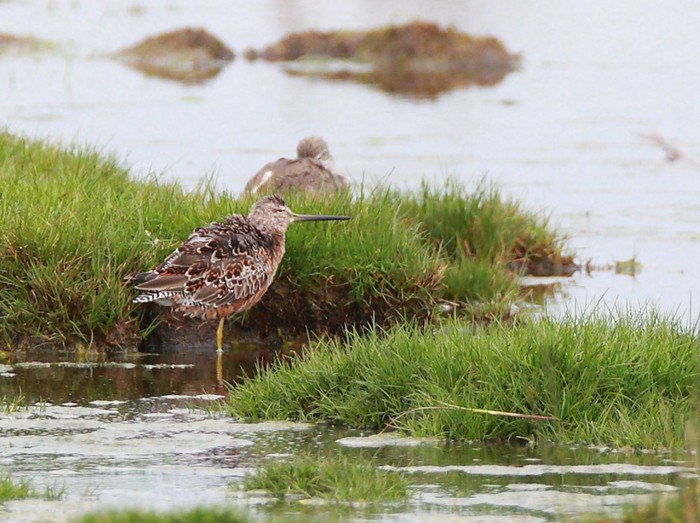
On the Highland island of Canna the wintering adult Franklin’s Gull was still present at Sanday on 12th. Numbers of other less-rare Laridae were becoming ever-thinner on the ground ~ only two Ring-billed Gulls to report this week, adults at Belfast Lough RSPB (Co. Antrim) on 12th and at Lurgangreen (Co. Louth) on 13th-14th. On Scilly, a possible first-summer (eminently splitable) Azorean Gull (atlantis) was on the airfield on 13th-14th ~ there’s one to get your teeth stuck in to…
The juvenile Kumlien’s Gull at Littlehampton (West Sussex) was in no mood to leave its south coast hidey-hole just yet, present throughout the week, with further late-leaving youngsters still at Swansea (Glamorgan) to 10th, at Ring (co. Cork) to 13th and Dawlish Warren on 14th, with two more Irish juvs the same day at Carne (Co. Wexford) and Larne Lough (Co. Antrim). In East Yorkshire, the second-winter Kumlien’s was seen heading south past Barmston on 12th.
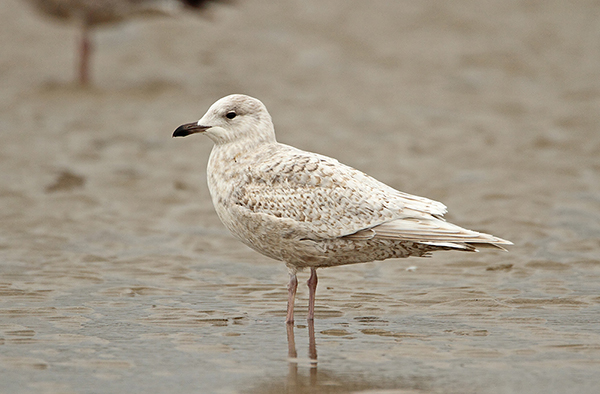
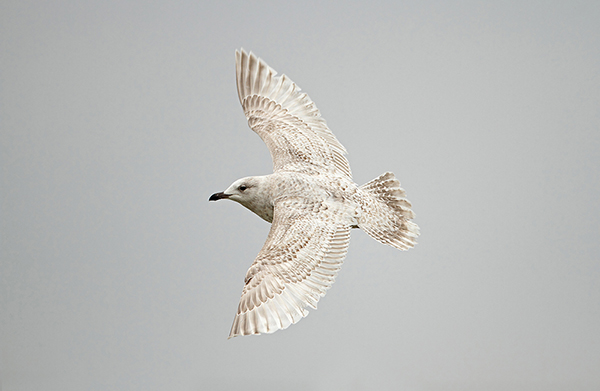
Iceland Gulls held at 43 over the past seven days ~ 39 in 18 British counties and regions, and just six birds in four Irish counties. Scotland’s tally of up to 15 was made up largely of some eight or nine birds on the Outer Hebrides, while the southwest of England’s 11 were boosted by up to four in Cornwall and three in Dorset. Yorkshire took all four of the records from the “northeast” ~ one each for each for North, East, South and West. Nice…
Numbers of Glaucous Gulls were just shy of the 40 mark ~ with nine around the Outer Hebrides during the week, including six (four juveniles and two adults) at Balranald RSPB on 14th. Elsewhere birds were thinly spread from Argyll to Cornwall (three in the latter) while two youngsters lingered at Dunster (Somerset) to 13th. Ireland’s half dozen were seen in Donegal, Cork, Waterford and Wexford.
Finally, in Galway Bay at Tawin, birders hunting last week’s returning Pacific Diver may have drawn a blank where the Gavia was concerned but did find the wintering Forster’s Ternon 11th. So it wasn’t such a bad day out…
On the Scottish Mountains of Aberdeenshire, on Glas Maol, a Snowy Owl was seen on 11th while the rather less rugged and Ptarmigan-free environs of Norfolk’s Breckland saw a White-tailed Eagle head across Lyford Arboretum to give Crossbill watchers a break on the afternoon of 13th. What must have been the same bird was seen earlier in the day at Beccles (Suffolk) while a couple of days previously, North Yorkshire clocked up their second barn door within a few weeks, one seen heading towards Sleddale on 11th.
Further wintery fare came in the shape of Rough-legged Buzzards at Donna Nook and Saltfleetby (Lincolnshire) on 9th with another reported from East Tuddenham (Norfolk) the same day, and one at Saltwood, near Hythe (Kent) ~ you’re a little late for the Chinese take-away old fruit…
A westward bound Black Kite reported over Scolt Head Island (Norfolk) on 9th ended up at Holme later the same day and was claimed again on 10th with a further report coming of a bird south there on 12th. Locals are keen to know more…answers on a postcard to Holme NWT and not RBA. Ta...
East Yorkshire was certainly in a rich vein of early-ish April form this week ~ adding to the frenzy of interest around an “available” three day Crag Martin, the county also hosted an Iberian Chiffchaff (in an area with no general access sadly) and a very showy and obliging Tawny Pipit too.
After a couple of false starts with the teasing Phylloscopus already this year (in London and Hampshire), we seem to have got the real deal at Grimston on 13th when a singing male Iberian Chiffchaff announced itself to locals during the early morning shift.
Despite registering around half the numbers of Pied-billed Grebe there never seems to be much excitement where this relatively recent split is concerned ~ general apathy, coupled with trixy mixed singers muddy the waters along with a quiet distrust of just how valid a species it really is all make the appearance of Iberian Chiffchaff feel rather damp and squibish. Which is a shame as these subtle inter-continental waifs are what some would label a proper “birder’s bird”.
To the end of 2012, there were 31 accepted records of the species ~ the first twitchable bird coming in 1999 on the Verne, on Portland, with records pre-dating it from Scilly in 1992 and London in 1972. There are two accepted records in East Yorkshire, the first was found at Easington in May 2004 and the second came to this week’s site, Grimston in June 2010. Since then, a calling only bird was logged at Flamborough Head in April last year ~ and that still waits the official thumbs up.
Flamborough’s second goodie of the week was found on CM Day ~ and generated a great deal of interest too ~ as nice early spring Tawny Pipits aren’t exactly prolific and who doesn’t love a padder (and doubtless it was lifer for some of the CM listers too…).
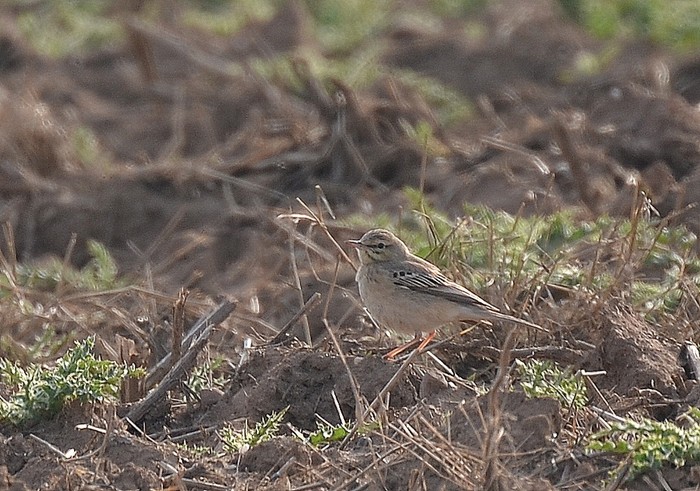
Tawny Pipit has become a far scarcer species than it once was (even in the days when it was a “BB” rarity) and a glance at recent reports of the species shows up any number of possibles and probable so it isn’t much of a surprise that Flamborough’s Supporting Cast was so well received ~ obliging all between 11th-15th. A little further to the south, a Richard’s Pipit was noted heading over The Warren, at Spurn on 10th.
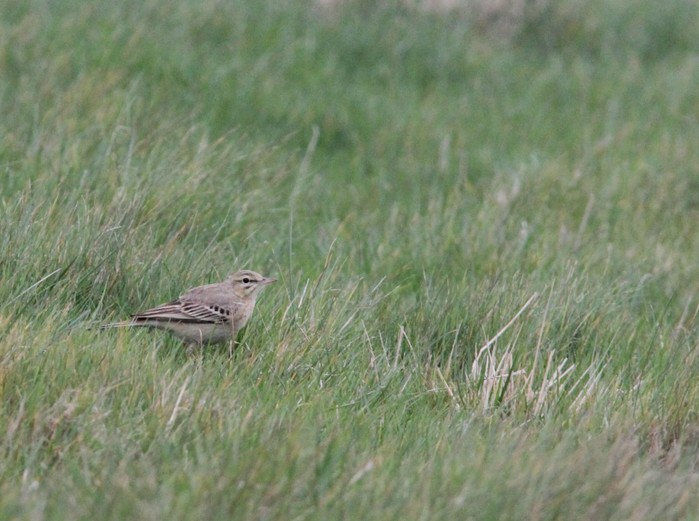
Two species arriving bang on cue this week were the first Eastern Subalpine Warbler and White-spotted Bluethroat of 2014.
Dorset laid claim to the Eastern Subalpine Warbler, a male albistriata seen at Swanage on 11th, tho’ news didn’t emerge until after the weekend. This will be your next armchair tick folks as the three way spilt of Western, Eastern and Moltoni’s looms closer and closer. Most have seen the first two, but few have managed a definitive for the third. Either way, the males of all three Sub-A species rock and are not to be missed if you can help it.
The south coast is certainly where you may expect to bump in to a dinky Sylvia but the location for the White-spotted Bluethroat was anything but obvious ~ the female-type at Wellington GPs (Herefordshire) on 12th being an outstanding find ~ the first record of any Bluethroat in the county for an age at least.
Even more unexpected than a White-spotted Bluethroat in Herefordshire was a Serin on the Outer Hebrides but a female in gardens at South Glendale on South Uist was a super island first and she obliged Hebridean listers by showing until 13th. Three south coast Serins were noted on 9th ~ at Dungeness and North Foreland (Kent) and Hengistbury Head (Dorset) while one spent a little bit of time on the Spurn Peninsula on 12th and one (surely not the same one?) went south over Frampton Marsh RSPB the next day.
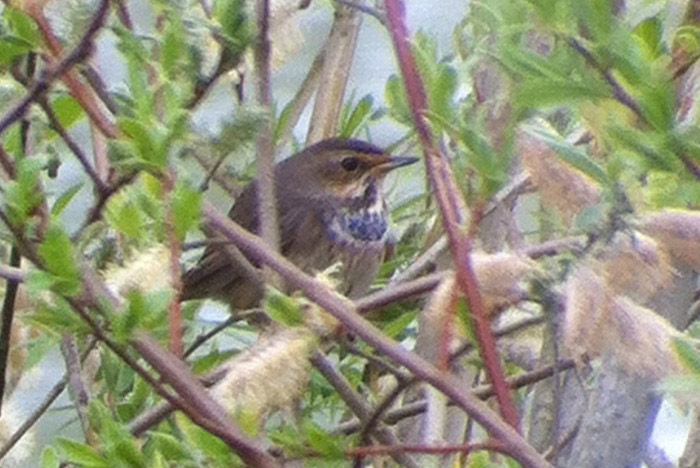
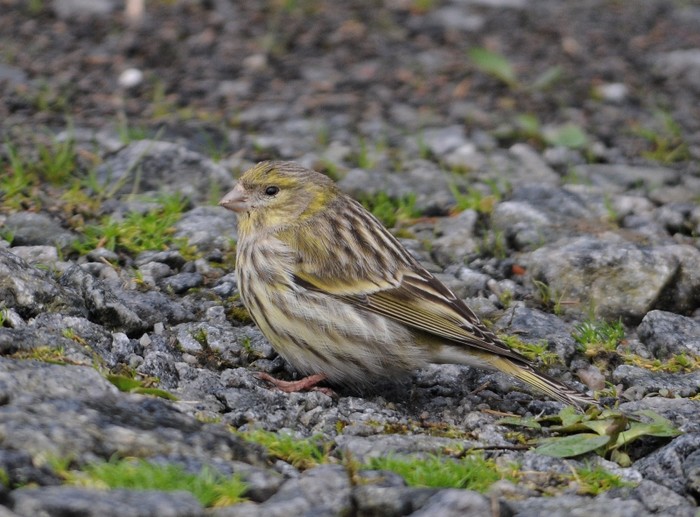
Perhaps as many as 18 Hoopoes were reported through the week, including a small flock of three at Berry Head (Devon) on 14th. New singles were at the Naze (Essex) and Beesands Ley (Devon) on 9th, at both Church Norton and Bognor Regis (West Sussex) on 10th, along the Gower (Glamorgan) and at Skipsea (East Yorkshire) on 11th and on 12th, reports came from Porlock (Somerset), Weston (Hertfordshire), Runcorn (Cheshire) and Todmorden (West Yorkshire). The final newbies of the week came at Greylake RSPB (Somerset) and near Torcross (Devon) on 15th ~ could the last one maybe just have moved from Beesands?
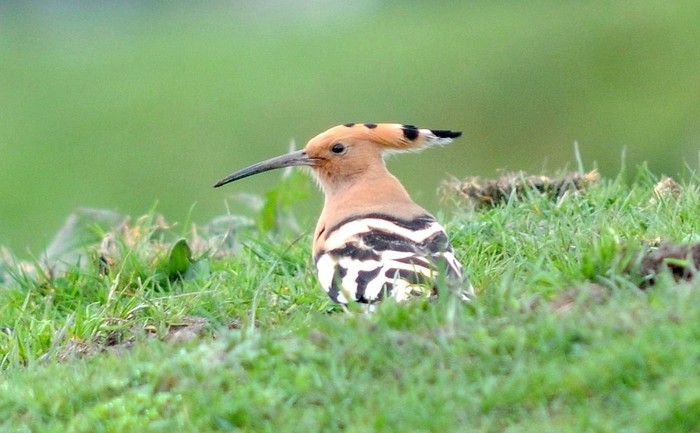
Lingering Hoopoes remained at Nocton (Lincolnshire) to 9th, Mizen Head (Co. Cork) and Monreith (Dumfries & Galloway) to 11th and Snodland (Kent) to 15th.
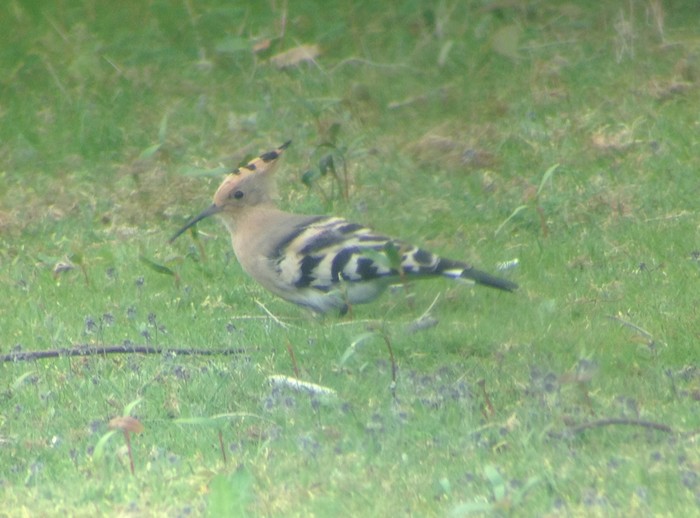
More Mediterranean colour came via the always-lovely aerial vision of Red-rumped Swallow, three of which were found across the past week. One was found at Owenahincha (Co. Cork) on 10th and was followed by a showy bird at Felbrigg (Norfolk) on 12th-13th and another at Rainton Meadows DWT (Co. Durham) on 13th. Norfolk’s first Wryneck of 2014 was found in the dunes at Winterton NNR on 10th and another followed on St. Martin’s (Scilly) on 15th while over on St. Mary’s, a Bee-eater was located near the school at Carn Gwarval on St. Mary’s on 15th.
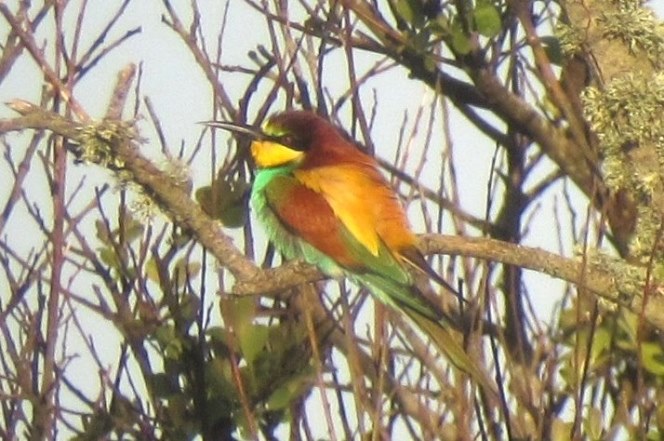
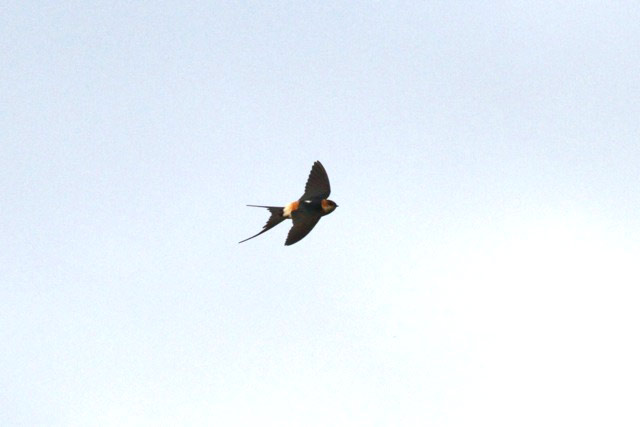
Both of the winter Dusky Warblers were still on station this week, at both Oulton Broad (Suffolk) and Great Barr, Birmingham (West Midlands) to 13th with a photo even coming along for the garden bird in the heart of the country. The Dungeness Hume’s Yellow-browed Warbler was present to 13th with both of the late-leaving Yellow-browed Warblers in Somerset and Worcestershire, still around at Bruton to 13th and Uffmoor Wood to 15th.
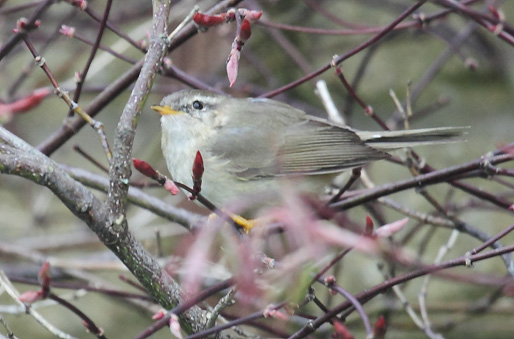
Seven Great Grey Shrikes were recorded on the first day of the review period, with two in the New Forest, singles still in Greater Manchester at Rochdale and in Denbighshire, at World’s End with new birds at Dyfant Forest (Powys), Stoke Moor (Somerset) and Loch of Harray on the Orkney Mainland. A third bird was in the New Forest on 10th (this one at Bishop’s Dyke again), with a further mover found at Dalby Forest (North Yorkshire) on 11th while one remained at Cross Forest Inn (Ceredigion) to 13th. The last bird was seen near East Fortune (Lothian) on 15th but later died.
At least five Two-barred Crossbills, four of them males, were still at Broomhead Reservoir (South Yorkshire) to 11th while four birds (two adult males, a female and the dodgy, much-discussed young male thingy) were at Lynford Arboretum (Norfolk) to 13th. The lone male was back at Dove Stone RSPB, on Saddleworth Moor (Greater Manchester) from 10th while the female remained elusive in Leith Hill Wood (Surrey) to 11th. The Kentish male, at Hemsted Forest, was hanging around until 13th.
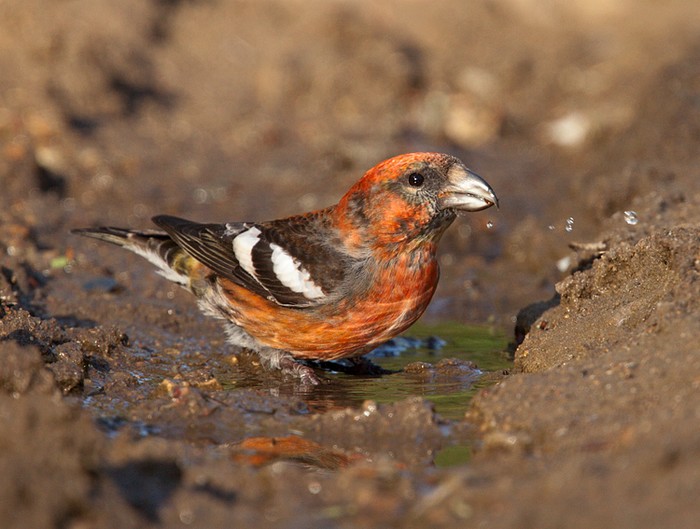
The weather looks set fare, conditions not too far from ideal for common, scare and rare migrants to make their way across the continents to our (currently) sunny shores. It looks like it’ll be warmer for those in the south but quite where the birds will appear is one to ponder on. A juicy high pressure and lightish north or northeasterlies seems to favour the east coast but the south is ready to pounce with a Mega reply to East Yorkshire offering of this week.
We’re edging towards the very broad “anything can happen” spring corridor now and admirers of rare sylvias would do well to start checking for Sardinians as well as Subalpines this week. Rarer still, Rock Thrush ~ we’re not too far off the date of Spurn’s popular bird of last year now, whilst it seems as though Alpine Accentor is loooong overdue for many….
...and this week sees the 10th anniversary of the last Alpine Accentor anywhere come along ~ an afternoon and evening bird that delighted many Norfolk listers along the undercliff at Overstrand on April 20th 2004, one of five records for the month (and the second one in Norfolk).
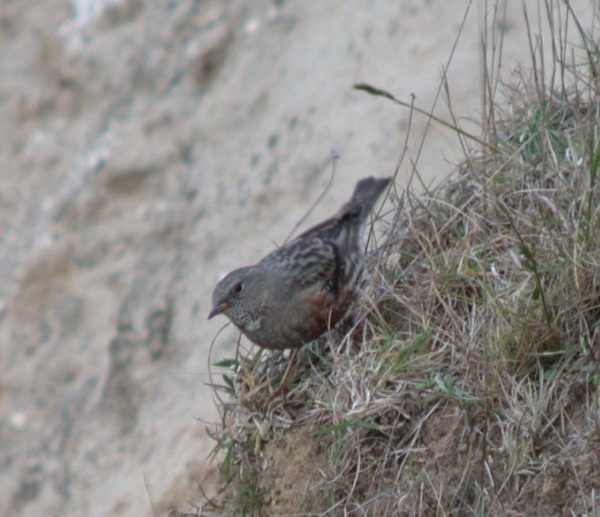
And April 20th is actually a day that rare-finders should keep half an eye on this week ~ previous 20/04’s have yielded summer fayre that has included no fewer than ten Subalpine Warblers, nine Black Kites, five Black-winged Stilts, four Little Bitterns and three Sardinian Warblers.
One April 20th in particular will always be engrained on the minds of rare-hunters everywhere ~ that amazing day on a cool Sunday in 2008 which produced a Calandra Lark on Shetland and a Black Lark in Norfolk.
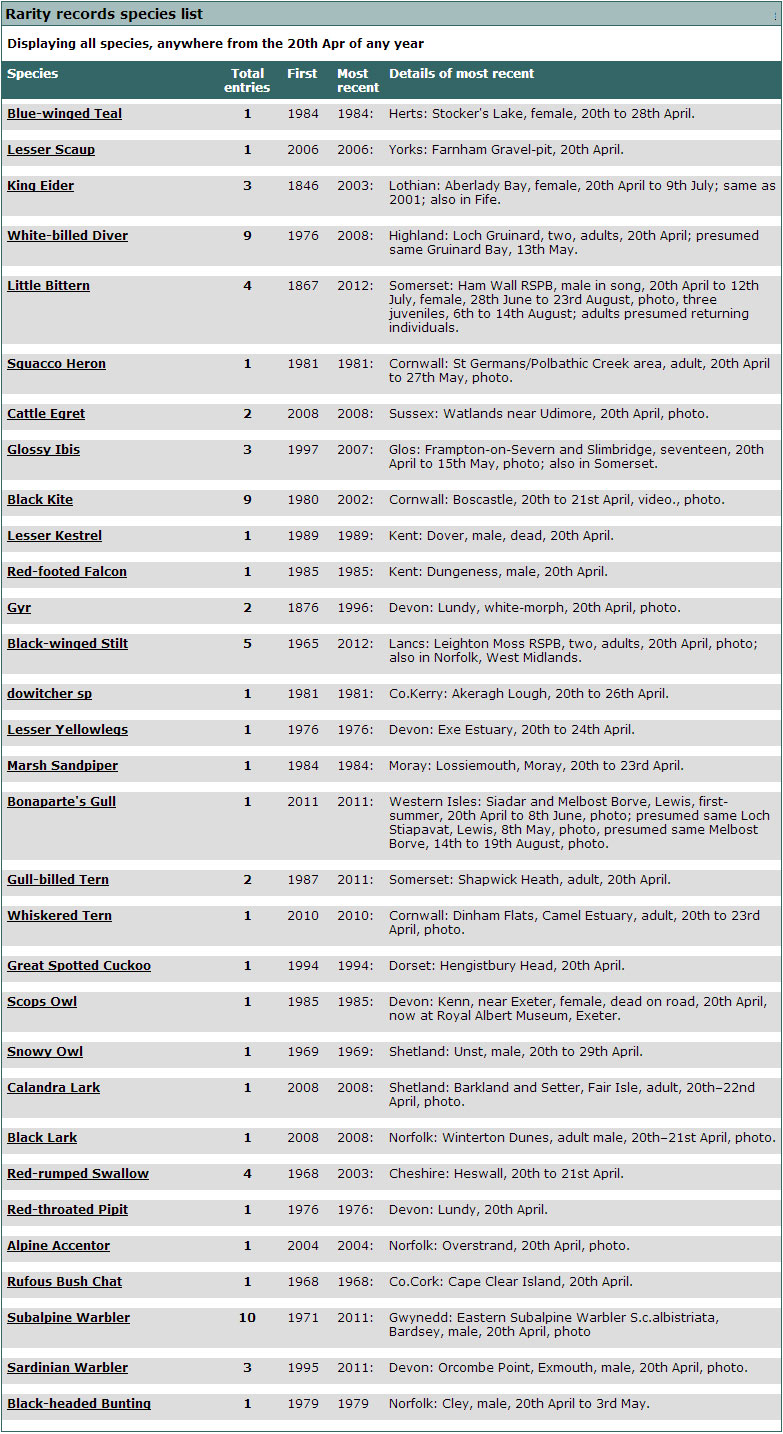
It looks like its getting tasty…and with the fourth vagrant Caspian Plover clocked up in France this week (after the birds in the Netherlands, Finland and Sweden), well may be it will be our turn for the next one…April 20th maybe?
Mark Golley
15 April 2014
Thanks to this week's contributors for their photos and videos








